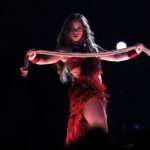“Dancing in the Moonlight” is a song that radiates pure joy and escapism. Originally written by Sherman Kelly in 1969 and first hitting the charts with King Harvest in 1972, this track has seen numerous covers. However, for many, the 1999 rendition by Toploader remains the definitive version. Toploader’s take amplified the song’s inherent charm, making it a staple at parties and a feel-good anthem for generations. Sherman Kelly himself described the song’s genesis as “envisioning an alternate reality, the dream of a peaceful and joyful celebration of life.” This vision clearly resonated, as evidenced by stories of the song soundtracking late-night pub lock-ins, becoming the perfect end-of-night anthem for good times shared. But what are the musical ingredients that give “Dancing in the Moonlight” its unique, uplifting vibe, and how can you capture that magic yourself by playing it?
Unpacking the Musical Magic of Toploader’s Hit
Toploader’s version masterfully builds on the original’s foundation, enhancing its dreamy and joyful qualities. The song immediately transports you with its iconic opening, driven by a combination of keyboard textures. The “twinkly” organ sound, pitched high, evokes a sense of nighttime wonder and fantasy, like shimmering moonlight itself. In Toploader’s arrangement, this is layered with long, sustained keyboard chords that establish the harmonic structure, and a more traditional piano sound that injects rhythmic drive and movement right from the start. This distinctive intro, a recurring motif throughout the song, is so recognizable that just a few notes are enough to identify it instantly. This sonic signature, also present in the King Harvest version with Kelly’s involvement, underscores his intention to create an “alternate reality” through sound.
Beyond the captivating keyboards, the rhythm of “Dancing in the Moonlight” contributes significantly to its laid-back yet infectious feel. The music possesses a gentle lilt, characterized by subtle syncopation. This rhythmic technique, where emphasis is placed on off-beats, creates a relaxed, almost calypso-like groove, enhancing the song’s peaceful and carefree atmosphere. It’s this rhythmic undercurrent that subtly compels you to move and tap your feet, embodying the “dancing” spirit of the title.
And then there’s the bassline – undeniably one of the most joyful and danceable basslines in popular music. It’s melodic, energetic, and perfectly complements the rhythmic foundation, driving the song forward with an irresistible buoyancy. Coupled with an incredibly simple and singable melody, primarily using stepwise motion (notes close together in pitch), the song becomes instantly accessible to anyone, regardless of singing ability. The addition of hand claps further encourages participation, transforming listening into a communal experience. When everyone joins in, singing and clapping along, the feeling of joy and collective celebration becomes truly palpable and “exponential,” as the original article aptly describes.
Playing “Dancing in the Moonlight”: Toploader Chords and Structure
For aspiring musicians, learning to play “Dancing in the Moonlight” is incredibly rewarding, offering a chance to tap into its inherent joy and share it with others. The song is built upon a relatively straightforward chord progression, making it accessible for guitarists and keyboardists of varying skill levels.
While the exact chord voicings and nuances can be explored in detail, the fundamental chord structure of the Toploader version revolves around a few key chords. Understanding these basic chords is the first step to playing along and capturing the song’s essence. Commonly played in the key of D major (though sometimes transposed), the song prominently features chords like:
- D Major: The root chord, providing a bright and stable foundation.
- G Major: A comfortable and uplifting major chord, creating a pleasant harmonic movement.
- A Major (or A7): The dominant chord, adding a touch of tension and resolution back to the D major.
- Bm (B minor): A minor chord that adds a hint of melancholy and harmonic interest, preventing the progression from becoming too simplistic.
These chords, when combined in the song’s progression, create the characteristic feel-good harmony of “Dancing in the Moonlight”. The song structure is also relatively simple and repetitive, making it easy to learn and memorize. It typically follows a verse-chorus structure, with the iconic intro serving as a recurring instrumental hook.
Learning the basic chord shapes for D, G, A, and Bm (or their variations) is the starting point. Numerous online resources provide chord diagrams and tutorials specifically for “Dancing In The Moonlight Toploader Chords.” Practicing the chord changes smoothly and in time with the song is key to capturing the rhythmic feel. Experimenting with different strumming patterns or keyboard voicings can further personalize your rendition and explore the song’s musical depth.
Embrace the Moonlight and the Music
“Dancing in the Moonlight” by Toploader is more than just a song; it’s an experience. It’s an invitation to step into that “alternate reality” of joyful celebration envisioned by its creator. Whether you’re listening to it, singing along, or learning to play the chords yourself, the song’s magic is undeniable. So, pick up your instrument, find the “dancing in the moonlight toploader chords”, and let the music transport you to a place of pure, unadulterated joy.
Alt text: Toploader band performing live on stage, capturing the energy and joyful performance associated with “Dancing in the Moonlight”.

